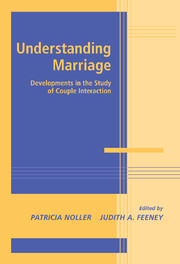Book contents
- Frontmatter
- Contents
- Contribitors
- Introduction
- SECTION ONE THE EFFECT OF COGNITION ON INTERACTION PATTERNS
- SECTION TWO UNDERSTANDING THE IMPORTANCE OF POSITIVE INTERACTION
- SECTION THREE COPING WITH DISAPPOINTMENT, CRITICISM, AND BETRAYAL
- SECTION FOUR POWER, CONFLICT, AND VIOLENCE IN MARITAL INTERACTION
- Marital interaction at important transition periods
- SECTION SIX Interventions for strengthening relationships
- Introduction to Section Six
- 17 Risk Factors, Risk Processes, and the Longitudinal Course of Newlywed Marriage
- 18 Does Working at a Relationship Work? Relationship Self-Regulation and Relationship Outcomes
- Conclusions
- Index
- References
18 - Does Working at a Relationship Work? Relationship Self-Regulation and Relationship Outcomes
Published online by Cambridge University Press: 25 July 2009
- Frontmatter
- Contents
- Contribitors
- Introduction
- SECTION ONE THE EFFECT OF COGNITION ON INTERACTION PATTERNS
- SECTION TWO UNDERSTANDING THE IMPORTANCE OF POSITIVE INTERACTION
- SECTION THREE COPING WITH DISAPPOINTMENT, CRITICISM, AND BETRAYAL
- SECTION FOUR POWER, CONFLICT, AND VIOLENCE IN MARITAL INTERACTION
- Marital interaction at important transition periods
- SECTION SIX Interventions for strengthening relationships
- Introduction to Section Six
- 17 Risk Factors, Risk Processes, and the Longitudinal Course of Newlywed Marriage
- 18 Does Working at a Relationship Work? Relationship Self-Regulation and Relationship Outcomes
- Conclusions
- Index
- References
Summary
Good marriages don't just happen – they take a lot of love and a lot of work.
—Tipper Gore, Life, February 1999Life happens and where does the magic go? Can it be revived? Yes, but it takes more than magic. It takes work; it takes time.
—Arp & Arp, 2001, p. 118The idea of making marriage work may seem to conflict with how relationships should be – magical and romantic. … But, if couples can learn how to make the magic themselves, then they will be able to keep their relationship's promise – the creation of a better life together.
—Lucas, 1997, p. 11Happiness in marriage is entirely a matter of chance.
—Jane Austen, Pride and Prejudice, p. 1It is a commonly held belief in western cultures that successful marriage requires work by the partners. In the first quote above, a prominent member of the American community proffers the view that partners need to work at their relationships. In the next two quotes, some authors of widely read popular books on marriage express a similar idea. However, as the final quote from one of the world's best-known romantic writers demonstrates, the view that work is a major determinant of marital satisfaction is not universally endorsed.
In this chapter, we describe a program of research evaluating the proposition that the work or effort that partners put into their relationship determines, in part, whether couples sustain relationship satisfaction.
- Type
- Chapter
- Information
- Understanding MarriageDevelopments in the Study of Couple Interaction, pp. 493 - 518Publisher: Cambridge University PressPrint publication year: 2002
References
- 4
- Cited by



